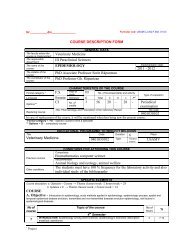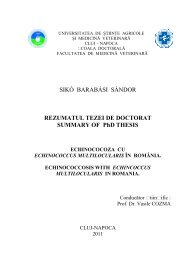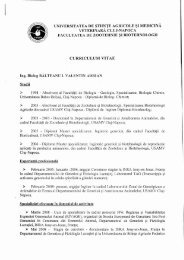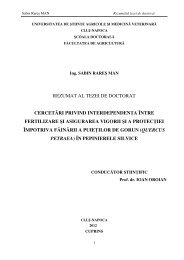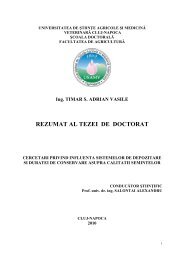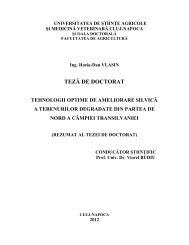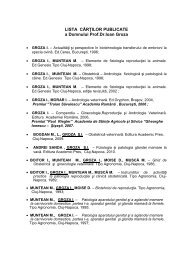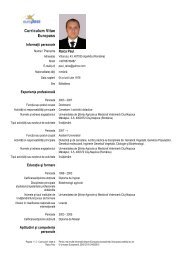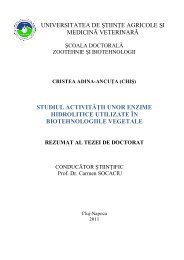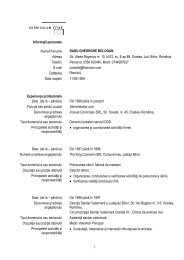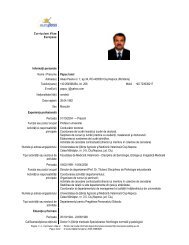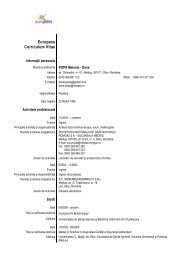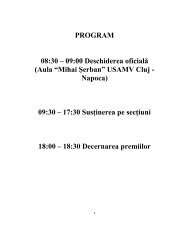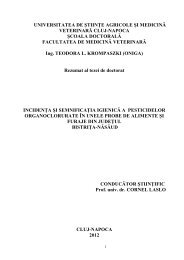self evaluation report - Universitatea de Ştiinţe Agricole şi Medicină ...
self evaluation report - Universitatea de Ştiinţe Agricole şi Medicină ...
self evaluation report - Universitatea de Ştiinţe Agricole şi Medicină ...
Create successful ePaper yourself
Turn your PDF publications into a flip-book with our unique Google optimized e-Paper software.
the Senate meetings and by discussions held with the administrative staff representatives. Consequently, the<br />
work of the <strong>self</strong>-<strong>evaluation</strong> group was supported by all institutional structures.<br />
2. INSTITUTIONAL CONTEXT<br />
2.1. A brief historical overview<br />
The University of Agricultural Sciences and Veterinary Medicine Cluj-Napoca is the continuer of the prestigious<br />
high school of agriculture from Cluj that was foun<strong>de</strong>d 143 years ago, based on a long tradition dating back to<br />
the fifteenth century with agriculture topics that were taught by Jesuit monks in the trivium that was set on<br />
the present site of the university campus. The history of the University of Agricultural Sciences and Veterinary<br />
Medicine Cluj Napoca began in October 1869 when on the former domain of Mănăştur, one of the ol<strong>de</strong>st<br />
European higher schools for agriculture named “The Institute of Agronomic Studies Cluj-Mănăştur” was<br />
foun<strong>de</strong>d, located within the premises of a former convent. In 1906 the Institute reached the level of aca<strong>de</strong>my,<br />
becoming “The Aca<strong>de</strong>my of Agriculture Cluj”. For almost 50 years from when it was foun<strong>de</strong>d and until the end<br />
of the second <strong>de</strong>ca<strong>de</strong> of the last century, the Aca<strong>de</strong>my activity was based on one <strong>de</strong>partment only, of<br />
Agriculture, whose studies lasting for three years and which awar<strong>de</strong>d the title of "Agronomist diplomat"<br />
gra<strong>de</strong>. The Aca<strong>de</strong>my of Agriculture Cluj continued its activity until the beginning of World War I.<br />
The creation of the Romanian United National State in 1918 marked the beginning of a new stage in the<br />
evolution of “The Aca<strong>de</strong>my of Agriculture Cluj”. Starting with 1921, the studies agronomic aca<strong>de</strong>mic education<br />
in Romania become of four years of study, of which three were for theoretical studies and the fourth year<br />
consisted of an internship within farms. Since 1922, the graduates received the <strong>de</strong>gree of “Agronomic<br />
engineer”. In 1929, following the reorganization and mo<strong>de</strong>rnization of the Romanian higher agronomic<br />
education, the Aca<strong>de</strong>my became the “The Aca<strong>de</strong>my of High Agronomic Studies Cluj”. The duration of studies<br />
was increased at that time to five years, and was organized on two cycles: "general education" (core subjects)<br />
lasting three and a half years, and "specialized education" extending over one and a half years. Through these<br />
studies, the Aca<strong>de</strong>my formed both agronomic engineers and researchers in various branches of agricultural<br />
sciences.<br />
Following the Vienna Dictate, from 1940 to 1945 the Aca<strong>de</strong>my (faculty, stu<strong>de</strong>nts, and part of its inventory)<br />
took refuge in Timisoara, where they carried out their activity as the “Faculty of Agronomy Cluj – Timișoara”.<br />
In 1945 the Aca<strong>de</strong>my returned to Cluj and reorganized in 1948 as “Agricultural Institute”.<br />
Initially the Institute operated only with a Faculty of Agriculture. In 1935 within the Faculty of Agriculture it<br />
was established a <strong>de</strong>partment of Animal Science that was transformed, in 1968, into the Faculty of Animal<br />
Science. In 1992 new biotechnology studies were <strong>de</strong>veloped so the faculty became the Faculty of Animal<br />
Science and Biotechnology. The Faculty of Veterinary Medicine was foun<strong>de</strong>d in the year 1962 and the Faculty<br />
of Horticulture in the year 1977.<br />
Starting with 1990, the Agronomic Institute activity was organized into four faculties: Agriculture, Horticulture,<br />
Animal Husbandry and Biotechnology and Veterinary Medicine, having a total of 1,750 stu<strong>de</strong>nts. On the 28 th of<br />
July 1995 in accordance to the Government Decision No. 586, the institution received its present name as<br />
"University of Agricultural Sciences and Veterinary Medicine Cluj-Napoca".<br />
An important historical evi<strong>de</strong>nce on the important role of our institution both in the <strong>de</strong>velopment of the<br />
Romanian agricultural education and in that of our society is presented in the volume “Tradiție și Inovație în<br />
Învățământul Agricol din Transilvania – Vol.I De la începuturi până în 1945” (Tradition and Innovation in<br />
Agricultural Education in Transylvania – Volume I From the beginning until 1945), published at the end of the<br />
year 2011 and being the first volume of an ample history of The University of Agricultural Sciences and<br />
Veterinary Medicine Cluj-Napoca.<br />
Since 1999 Romanian universities started to reform in accordance to the Bologna system, aiming to integrate<br />
into the European Higher Education Area. Being aware about the necessity of an international <strong>evaluation</strong> to<br />
assess the university improvement and the status of its quality assurance system, USAMV Cluj-Napoca <strong>de</strong>ci<strong>de</strong>d<br />
in 2003 to apply for the EUA institutional <strong>evaluation</strong>. The final Evaluation <strong>report</strong> issued by EUA in July 2003<br />
(see: Appendix – Institutional <strong>evaluation</strong> process), un<strong>de</strong>rlined by its conclusion that: “USAMV can be a source<br />
Page 2 SELF-EVALUATION REPORT, March, 2012



